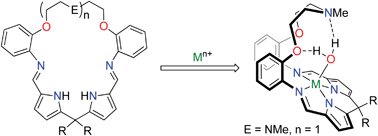As Jason Love described in his 2009 ChemComm Feature Article, pyrrole-based macrocycles are ideal ligands for creating pre-organised metal binding sites to enable the multielectron redox chemistry so required for transforming small molecules such as O2, carbon dioxide and water.
Here in their latest Dalton Transactions article, Love and colleagues take this a step further.
The team note how their previous attempts to make mononuclear transition metal complexes with the donor ligands were unsuccessful. Despite significant efforts, they could only make bimetallic complexes – well, until now that is…
The newest set of ligands now incorporate N4¬ with either O5 or ONO donors which are separated through aryl spacers. Upon binding of a singular metal atom, the complexes fold to form a Pacman-like cleft structure. Love and colleagues expect the structure to play host to guest molecules which can benefit from metal coordination as well as hydrogen bonding interactions to the oxygen and nitrogen atom acceptors.
To read more, download the article now…
Synthesis and structures of transition metal pacman complexes of heteroditopic Schiff-base pyrrole macrocycles
James W. Leeland, Colin Finn, Bérengère Escuyer, Hiroyuki Kawaguchi, Gary S. Nichol, Alexandra M. Z. Slawin and Jason B. Love











